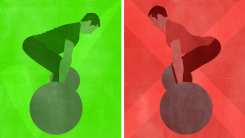The deadlift, a fundamental exercise in strength training, is often plagued by numerous mistakes that can hinder progress and increase the risk of injury. This article aims to shed light on some of the most common errors encountered during deadlifting and provide practical solutions for rectifying them. By addressing these issues with precision and adopting proper form, individuals can optimize their deadlift performance while minimizing potential harm.
Inadequate Hip Hinge: The Foundation of Deadlifting
A crucial aspect frequently overlooked is the hip hinge technique when performing a deadlift. Many individuals fail to initiate movement from their hips, resulting in excessive strain on the lower back and reduced engagement of posterior chain muscles such as glutes and hamstrings. To address this issue, it is imperative to focus on maintaining a neutral spine throughout the lift while actively pushing your hips backward before initiating upward movement.
Grip Strength Limitations: A Common Weak Link
Another prevalent mistake observed among novice lifters is insufficient grip strength during deadlifting exercises. Inadequate grip not only compromises lifting capacity but also increases reliance on other muscle groups unnecessarily. To overcome this limitation, incorporating specific grip-strengthening exercises into your training routine can significantly enhance overall performance. Utilizing tools like thick barbells or implementing farmer’s walks with heavier weights are effective strategies for developing robust hand and forearm muscles.
Rounding of the Lower Back: An Invitation to Injury
Maintaining proper spinal alignment throughout each phase of a deadlift is paramount for avoiding potential injuries; however, rounding of the lower back remains one of the most frequent mistakes made during this exercise. This faulty posture places excessive stress on intervertebral discs and surrounding structures, increasing susceptibility to strains or herniations. To rectify this issue, individuals should focus on engaging their core muscles and maintaining a neutral spine position throughout the entire movement. Strengthening exercises targeting the erector spinae and deep abdominal muscles can aid in developing the necessary stability for a safe deadlift.
Conclusion: Perfecting Your Deadlift Technique
In conclusion, mastering proper deadlift technique is essential for maximizing gains while minimizing injury risk. By addressing common mistakes such as inadequate hip hinge, grip strength limitations, and rounding of the lower back, individuals can optimize their performance during this foundational exercise. Incorporating targeted exercises to strengthen weak areas and focusing on maintaining correct form will contribute to improved deadlifting proficiency over time. Remember that seeking guidance from qualified professionals or trainers with expertise in strength training techniques is always advisable to ensure optimal results.


